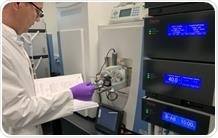A team from SPI in Marcoule detected by mass spectrometry, in 3 minutes and without specific reagents, signature peptides of the SARS-CoV-2 virus in clinical samples (nasopharyngeal swabs). It thus provides a proof of concept of the use of this method as a possible alternative to PCR, currently the reference method.

Image Credit: J. Armengaud/CEA
Rapid but yet sensitive, specific and high-throughput detection of the severe acute respiratory syndrome coronavirus 2 (SARS-CoV-2) in clinical samples is key to diagnose infected people and to better control the spread of the virus. Alternative methodologies to PCR and immunodiagnostic that would not require specific reagents are worth to investigate not only for fighting the COVID-19 pandemic, but also to detect other emergent pathogenic threats.
In the present study, scientists from SPI (Marcoule) propose the use of tandem mass spectrometry to detect SARS-CoV-2 marker peptides in nasopharyngeal swabs. They documented that the signal from the microbiota present in such samples is low and can be overlooked when interpreting shotgun proteomic data acquired on a restricted window of the peptidome landscape.
In this proof of concept study, simili nasopharyngeal swabs spiked with different quantities of purified SARS-CoV-2 viral material were used to develop a nanoLC-MS/MS acquisition method, which was then successfully applied on COVID-19 clinical samples. Researchers argue that two peptides from the nucleocapsid protein are of utmost interest as their signal is intense and their elution can be obtained within a 3 min window in the tested conditions.
These results pave the way for the development of time-efficient viral diagnostic tests based on mass spectrometry.
Source:
Journal reference:
Gouveia, D., et al. (2020) Proteotyping SARS-CoV-2 Virus from Nasopharyngeal Swabs: A Proof-of-Concept Focused on a 3 Min Mass Spectrometry Window. Journal of Proteome Research. doi.org/10.1021/acs.jproteome.0c00535.